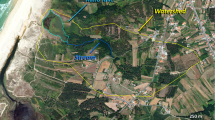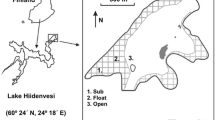Abstract
Lake Sagata (37° 49′ N, 138° 53′ E, alt. 4.5 m, depth 50–150 cm, area 0.375 km2) is one of about 20 sand-dammed lakes situated between two parallel sand dunes. Only spring water flows into the lake, which is surrounded by a comparatively broad Phragmites zone of 0.3 km2. Spring water containing a very high concentration of NO3, with 9.3 – 17.75 mg l−1, which seems to originate from agricultural cultivation on the periphery, flows into the lake. This decreases gradually as water flows through Phragmites belts and floating-leaved plant vegetation (Trapa spp. and Nelumbo nucifera) reached 0.01–0.07 mg l−1 in spillage water in summer. Chlorophyll-a concentrations in the lake ranged from 150 in spring to 400 mg m−3 in summer, showing progressive eutrophication compared with a condition of the lake in 1979. Macrophyte vegetation plays important roles with denitrification in the nutrient dynamics of shallow sand dune lakes.
Similar content being viewed by others
References
Braskerud, B. C., 2002. Factors affecting nitrogen retention in small constructed wetlands treating agricultural non-point source pollution. Ecol. Eng. 18: 351–370.
Cronk, J. K. & M. S. Fennessy, 2001. Wetland Plants: Biology and Ecology. Lewis Publishers, New York: 462 pp.
Fukuhara, H. & M. Ushijima, 1998. Limnological studies of lakes in Niigata Prefecture X. Changes in the area of emerged and floating-leaved plants, estimated by using aerial photographs in Lake Sagata (Akatsuka, Niigata). Memoirs of the Faculty of Education and Human Sciences, Natural Sciences, Niigata University 1: 1–15 (in Japanese with English summary).
Fukuhara, H., A. Ohtaka, N. Tomita, T. Nakamura & T. Higashide, 1990. Limnological studies of lakes in Niigata Prefecture VI. Limnological studies of Lake Sagata, with special reference to the seasonal changes in nutrients and macrophyte biomass. Memoirs of the Faculty of Education, Natural Sciences, Niigata University. 32: 1–24 (in Japanese with English summary).
Grootjans, A. P., W. H. O. Ernst & P. J. Stuyfzand, 1998. European dune slacks: string interactions of biology, pedogenesis and hydrology. Trends Ecol. Eval. 13: 96–100.
Grootjans, A. P., H., Everts, K. Bruin & L. Fresco, 2001. Restoration of wet dune slackes on the Duch Wadden Sea Island: Recolonization after large-scale sod cutting. Restor. Ecol. 9: 137–146.
Harris, G. P., 1986. Phytoplankton Ecology: structure, function and fluctuation. Chapman and Hall Ltd. Cambridge: 384 pp.
Horie, S., 1962. Morphometric features and the classification of all the lakes in Japan. Memoirs College of Sciences, University of Kyoto (B) 29: 191–262.
Jansson, M., R. Andersson, H. Berggren & L. Leonardson, 1994. Wetlands and lakes as nitrogen traps. Ambio 23: 320–325.
Kern, J. & C. Idler, 1999. Treatment of domestic and agricultural wastewater by reed bed systems. Ecol. Eng. 12: 13–25.
Kiss, M. K., G. Lakatos, G. Borics, Z. Gidó & C. Deák, 2003. Littoral macrophyteperiphyton complexes in two Hungarian shallow waters. Hydrobiologia 506–509: pp541–548.
Kobayashi, I., 1982. Natural environment of L. Sagata. In School board of Niigata City (ed.), Nature of L. Sagata, Niigata City, Niigata: 3–11.
Kufel, I. & L. Kufel, 1997. Eutrophication processes in a shallow, macrophyte-dominated lake – nutrient loading to and flow through Lake Luknajno (Poland). Hydrobiologia 342/343: 387– 394.
Kurata, A. & M. Satouchi, 1998. Function of a lagoon in nutrient removal in Lake Biwa, Japan. In Mitsch, W. J. & S. E. Jorgensen (eds), Ecological Engineering: An Introduction to Ecotechnology. John Wiley & Sons, New York: 219–230.
Lammerts E. J., C. Maas & A. P. Grootjans, 2001, Groundwater variables and vegetation in dune slacks. Ecol. Eng. 17: 33–47.
Matsumoto, S., 1987. Effect of macrophyte on the water quality and sediment characters in L. Toyanogata (Niigata City). Bulletin of Water Plant Society, Japan 27: 2–15 (in Japanese).
Niigata City, 1996. Technical report on the natural environment around L. Sagata. Niigata City, Niigta: 108 pp. (in Japanese).
Niigata City, 1998. Technical report on groundwater around L. Sagata. Niigata City, Niigta: 134 pp. (in Japanese).
Niigata City, 2000. Technical report on fish, zoobenthos, plankton communities in L. Sagata. Niigata City, Niigata: 123 pp. (in Japanese).
Niigata Prefecture, 1981. Technical report on groundwater around L. Sagata (1980). Niigata Prefecture, Niigata: 253 pp. (in Japanese).
Nonaka, M., R. Abe & H. Tanabe, 1997. Increasing groundwater nitrate nitrogen concentration in sand dune upland soil by fertilizer application. Sand Dune Research 44: 23–29 (in Japanese with English summary).
Pollet, M. & P. Grootaert, 1996. An estimation of the natural values of dune habitats using Empidoidae (Diptera). Biod. Conserv. 5: 859–880.
Reddy, K. R., W. H. jr. Patrick & C. W. Lindau, 1989. Nitrificationdenitrification at the plant root-sediment interface in wetlands. Limnol. Oceanogr. 34: 1004–1013.
Ruggiero, A., A. G. Solimini & G. Carchini, 2003. Nutrient and chlorophyll a temporal patterns in eutrophic mountain ponds with contrasting macrophyte coverage. Hydrobiologia 506–509: 657–663.
Tanaka, H., T. Hasegawa, S. Kimura, I. Okamoto & Y. Sakai, 1996. The geohistory of the formation of the Niigata Sand Dunes. Quaternary Research 35: 207–218 (in Japanese with English summary).
Author information
Authors and Affiliations
Rights and permissions
About this article
Cite this article
Fukuhara, H., Kawakami, A. & Shimogaito, T. Characteristics of nutrient dynamics in Lake Sagate, Japan, a shallow sand dune lake. Hydrobiologia 506, 93–99 (2003). https://doi.org/10.1023/B:HYDR.0000008557.62019.32
Issue Date:
DOI: https://doi.org/10.1023/B:HYDR.0000008557.62019.32




